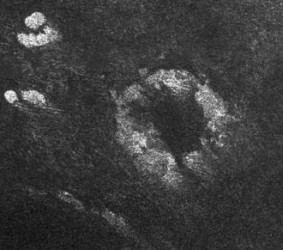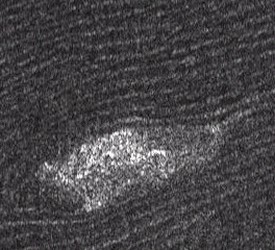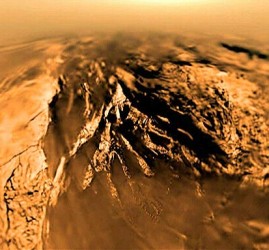|
The Huygens Probe The Huygens probe entered Titan's upper atmosphere at about 5:15 a.m. EST on January 14, 2005. During its two and one-half hour descent to the surface of the moon, it sampled the chemical composition of the atmosphere. The probe continued transmitting data for more than 90 minutes after reaching the surface. Above left is a photo transmitted from Huygens while it was still descending, showing the surface of Titan. The picture above right is an artist's rendition of the probe hitting the surface.
During its stay at Titan Cassini was scheduled to fly by the moon a total of 45 times. During a flyby in 2006, Cassini used radar to probe the surface. One of the most prominent features, Xanadu, is visible even from telescopes on Earth. Its origin is still unknown, but the radar images revealed details previously unseen, including features that may indicate the flow of liquid in the past. Xanadu's two prominent circular features are probably impact craters, but they could be calderas or volcanoes. Sand dunes, discovered in previous flybys, cover Titan's surface like vast oceans of sand.   Xanadu on the left; on the right, some of the many sand dunes that cover Titan's surface. Some of the sand dunes on Titan are 100 metres high, running parallel to each other for hundreds of kilometres at Titan's equator. One dune field is more than 1500 km long. Titan's atmosphere is thicker than Earth's, its gravity is lower, and its sand is different, but the processes that form dunes seem to be the same as the ones in the deserts of Earth. Researchers have discovered that Saturn's powerful gravity creates tides in Titan's atmosphere. Saturn's tidal effect on Titan is 400 times greater than our moon's tidal pull on Earth. These tides cause winds near the surface of Titan, which, combined with normal winds, create the sand dunes. Although the winds are quite gentle (half a metre per second), Titan's light gravity allows the sand grains, similar in size and texture to coffee-grounds, to be blown around the moon's surface.  More photos and information were released from the probe called Huygens that Cassini dropped onto the surface of Titan.
At first, the Huygens camera just saw fog over the distant surface; this started to clear at about 60 kilometers altitude, after which the surface could be seen. More photos and information were released from the probe called Huygens that Cassini dropped onto the surface of Titan.
At first, the Huygens camera just saw fog over the distant surface; this started to clear at about 60 kilometers altitude, after which the surface could be seen. The Cassini spacecraft continued to orbit Saturn for four years. Visit the Cassini-Huygens home page at http://www.esa.int/SPECIALS/Cassini-Huygens/index.html for discoveries made by the Huygens probe. There you can watch a movie of the Huygens descent. |